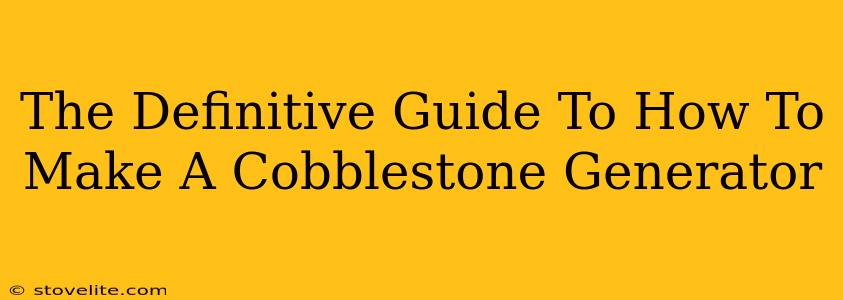Want to build a cobblestone generator in Minecraft? Tired of endlessly mining? You've come to the right place! This guide will walk you through building several different types of cobblestone generators, from simple to advanced, ensuring you'll never run short of this essential building block again.
Understanding the Fundamentals of Cobblestone Generation
Before diving into specific designs, let's grasp the core principle. Most cobblestone generators exploit the game's mechanics. Specifically, they leverage lava's interaction with water. When lava and water meet, they create cobblestone. The trick is to create a sustainable, automated system that constantly replenishes your supply.
Key Components:
- Lava Source: You'll need a reliable source of lava, either a naturally occurring lava pool or a lava bucket.
- Water Source: Similarly, a consistent water source, be it a flowing water block or a water bucket, is crucial.
- Collection System: This is the mechanism that gathers the newly formed cobblestone. This often involves hoppers, chests, and potentially other Redstone contraptions for more advanced designs.
Simple Cobblestone Generator (Beginner-Friendly)
This design is perfect for beginners and requires minimal resources and Redstone knowledge.
Materials Needed:
- Lava Bucket: One is enough to start.
- Water Bucket: Also just one.
- Hopper: To collect the cobblestone.
- Chest: To store your cobblestone.
Construction:
- Create the base: Dig a 2x2 hole.
- Place the lava: Pour a lava bucket into one of the squares.
- Place the water: Carefully pour a water bucket into the adjacent square. This will create a cobblestone column.
- Position the hopper: Place a hopper beneath the cobblestone generation point.
- Add the chest: Attach a chest to the hopper to collect your cobblestone.
This simple design produces cobblestone slowly, but it’s a great starting point for understanding the basics.
Advanced Cobblestone Generator (For Experienced Players)
For a more efficient system, let’s explore an automated design requiring Redstone knowledge. This design significantly increases cobblestone output.
Materials Needed:
- Lava Source: A sustainable lava source is ideal (like a lava pool).
- Water Source: Same as above, a sustainable source.
- Hoppers: Multiple hoppers for efficient collection.
- Chests: For storage.
- Redstone Dust: To power mechanisms (if applicable).
- Observers: To detect cobblestone generation and trigger mechanisms.
- Water Bucket: For initial setup.
- Lava Bucket: For initial setup.
Construction (Conceptual Outline):
This design is more complex and can be customized. The core concept is to create a continuous flow of lava and water, resulting in a constant stream of cobblestone. A system of observers can automatically replace water sources as needed, ensuring uninterrupted operation. The specific design details vary, often involving cleverly arranged water streams and mechanisms to prevent lava from spreading uncontrollably. Numerous tutorials available online show step-by-step instructions and visuals for various advanced designs.
Optimizing Your Cobblestone Generator
Regardless of the design you choose, consider these optimizations:
- Lava Source Reliability: Ensure your lava source is sustainable. If it's a finite pool, you might need a backup plan.
- Water Source Management: Prevent unintended water spread that could extinguish the lava.
- Efficient Collection: Use multiple hoppers and chests for maximum storage capacity.
- Redstone Control (Advanced): Use redstone to create automated systems for even more efficient cobblestone production.
Conclusion
Building a cobblestone generator in Minecraft is a rewarding endeavor that saves you countless hours of mining. Whether you opt for the simple or advanced design, the satisfaction of having an automated supply of cobblestone is unparalleled. Remember, practice makes perfect! Experiment with different designs and adapt them to your specific needs. Happy building!

